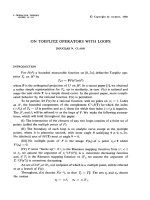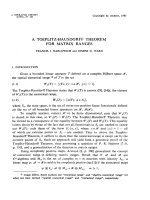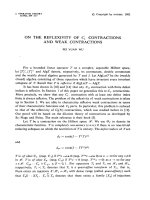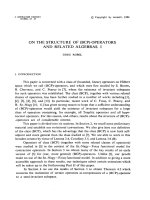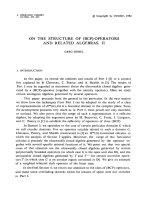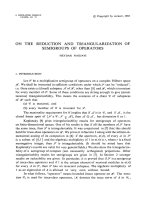Báo cáo toán học: "On rainbow trees and cycles" ppsx
Bạn đang xem bản rút gọn của tài liệu. Xem và tải ngay bản đầy đủ của tài liệu tại đây (120.85 KB, 9 trang )
On rainbow trees and cycles
Alan Frieze
∗
Michael Krivelevich
†
Submitted: Jan 4, 2007; Accepted: Apr 10, 2008; Published: Apr 18, 2008
Mathematics Subject Classification: 05C15
Abstract
We derive sufficient conditions for the existence of rainbow cycles of all lengths in
edge colourings of complete graphs. We also consider rainbow colorings of a certain
class of trees.
1 Introduction
Let the edges of the complete graph K
n
be coloured so that no colour is used more than
max {b, 1} times. We refer to this as a b-bounded colouring. We say that a subset S of the
edges of K
n
is rainbow coloured if each edge of S is of a different colour. Various authors
have considered the question of how large can b = b(n) be so that any b-bounded edge
colouring contains a rainbow Hamilton cycle. It was shown by Albert, Frieze and Reed
[1] (see Rue [7] for a correction in the claimed constant) that b can be as large as n/64.
This confirmed a conjecture of Hahn and Thomassen [5]. Our first theorem discusses the
existence of rainbow cycles of all sizes. We give a kind of a pancyclic rainbow result.
Theorem 1 There exists an absolute constant c > 0 such that if an edge colouring of K
n
is cn-bounded then there exist rainbow cycles of all sizes 3 ≤ k ≤ n.
Having dealt with cycles, we turn our attention to trees.
Theorem 2 Given a real constant ε > 0 and a positive integer ∆, there exists a constant
c = c(ε, ∆) such that if an edge colouring of K
n
is cn-bounded, then it contains a rainbow
copy of every tree T with at most (1 − ε)n vertices and maximum degree ∆.
∗
Department of Mathematical Sciences, Carnegie Mellon University, Pittsburgh PA15213, U.S.A. Sup-
ported in part by NSF grant CCF0502793.
†
School of Mathematical Sciences, Raymond and Beverly Sackler Faculty of Exact Sciences, Tel Aviv
University, Tel Aviv 69978, Israel. E-mail: Research supported in part by USA-
Israel BSF Grants 2002-133 and 2006-322, by grant 526/05 from the Israel Science Foundation and by
the Pazy memorial award.
the electronic journal of combinatorics 15 (2008), #R59 1
We conjecture that that there is a constant c = c(∆) such that every cn-bounded edge
colouring of K
n
contains a rainbow copy of every spanning tree of K
n
which has maximum
degree at most ∆. We are far from proving this and give a small generalisation of the
known case where the tree in question is a Hamilton path. Let T
∗
be an arbitrary rooted
tree with ν
0
nodes. Assume that ν
0
divides n and let ν
1
= n/ν
0
. We define T (ν
1
) as
follows: It has a spine which is a path P = (x
0
, x
1
, . . . , x
ν
1
−1
) of length ν
1
− 1. We
then have ν
1
vertex disjoint copies T
0
, T
1
, . . . , T
ν
1
−1
of T
∗
, where T
i
is rooted at x
i
for
i = 0, 1, . . . , ν
1
− 1. T (ν) has n vertices. The edges of T (ν
1
) are of two types, spine-edges
in P and teeth-edges.
We state our theorem as
Theorem 3 If an edge colouring of K
n
is k-bounded and
ν
1
−2
2
> 16kn then there exists
a rainbow copy of every possible T(ν
1
).
2 Proof of Theorem 1
We will not attempt to maximise c as we will be far from the optimum.
The following lemma is enough to prove the theorem:
Lemma 4
(a) Let c
0
= 2
−7
and suppose that n ≥ 2
21
. Then every 2c
0
n-bounded edge colouring of
K
n
contains rainbow cycles of length k, n/2 ≤ k ≤ n.
(b) If n ≥ e
1000
and cn ≥ n
2/3
and an edge colouring of K
n
is cn-bounded, then there
exists a set S ⊆ [n] such that |S| = N = n/2 and the induced colouring of the edges
of S is c
N-bounded where c
= c(1 + 1/(ln n)
2
).
We will first show that the lemma implies the theorem. Assume first that n ≥ e
1000
. We
let N
i
= 2
−i
n for 0 ≤ i ≤ r = log
2
(ne
−1000
) and note that N
i
≥ e
1000
> 2
21
for all i ≤ r.
Now define a sequence c
0
, c
1
, c
2
, . . . , c
r
by
c
i+1
= c
i
1 +
1
(ln N
i
)
2
.
Then for i ≥ 1 we have:
c
i
= c
0
i
s=1
1 +
1
(ln n − s ln 2)
2
≤ c
0
exp
1
(ln n)
2
i
s=1
1
1 −
s
log
2
n
2
the electronic journal of combinatorics 15 (2008), #R59 2
= c
0
exp
log
2
n
ln n
2
i
s=1
1
(log
2
n − s)
2
.
Then for all 0 ≤ i ≤ r we have:
c
0
≤ c
i
≤ c
0
exp
log
2
n
ln n
2
∞
t=21
1
t
2
≤ c
0
exp
2.1
∞
t=20
t
−2
dt
= c
0
exp
2.1
20
≤ 2c
0
.
Furthermore, for 0 ≤ i ≤ r we have n/2
r
> 2
21
and so
c
i
N
1/3
i
≥
c
0
n
1/3
2
i/3
≥ 1,
which implies that c
i
N
i
≥ N
2/3
i
.
Assume now we are given a c
0
n-bounded coloring of K
n
and that n ≥ e
1000
. Then by part
(a) of the lemma we can find rainbow cycles of length k, n/2 ≤ k ≤ n. By part (b) there
exists a subset S, |S| = n/2 = N, such that the induced coloring on S is c
1
n-bounded.
Now we can apply part (a) of the lemma to the induced subgraph G[S] to find rainbow
cycles of length k, n/4 ≤ k ≤ n/2. We can continue this halving process for r steps, thus
finding rainbow cycles of length k, N
r
≤ k ≤ n where e
1000
≤ N
r
≤ 2e
1000
.
To summarise: Assuming the truth of Lemma 4, if n ≥ e
1000
and c ≤ 2
−7
then any
cn-bounded coloring of K
n
contains a rainbow cycle of length 2e
1000
≤ k ≤ n.
Up to this point, the value of c is quite reasonable. We now choose a very small value of
c in order to finish the proof without too much more effort.
Suppose now that c ≤ e
−3001
, n ≥ e
1000
and 3 ≤ k ≤ min {2e
1000
, n}. Suppose that K
n
is
edge colored with q colors and that color i is used m
i
≤ cn times. Choose a set S of k
vertices. Let E be the event S contains two edges of the same color. at random. Then,
Pr(E) ≤
k
2
2
q
i=1
m
i
n
2
2
+
k
3
q
i=1
m
i
2
n
3
(1)
≤
k
2
2
n
2
cn
cn
n
2
2
+
k
3
n
2
cn
cn
2
n
3
≤
ck
2
n − 1
+
ck
3
4
< 1.
The two sums in (1) correspond to having two disjoint edges with the same color and to
two edges of the same color sharing a vertex, respectively.
All that is left is the case n ≤ e
1000
but now c is so small that cn < 1 and all edges have
distinct colors.
the electronic journal of combinatorics 15 (2008), #R59 3
2.1 Proof of Lemma 4
Part (a) follows immediately from [1] (n ≥ 2
21
is easily large enough for the result there
to hold). We can apply the main theorem of that paper to any subset of [n] with at least
n/2 vertices.
We now prove part (b). Let S be a random n/2-subset of [n]. Now for each colour i we
orient the i-coloured edges of K
n
so that for each v ∈ [n],
|d
+
i
(v) − d
−
i
(v)| ≤ 1
where d
+
i
(v) (resp. d
−
i
(v)) is the out-degree (resp. in-degree) of v in the digraph D
i
=
([n], E
i
) induced by the edges of colour i. Now fix a colour i and let
L
i
=
v : d
+
i
(v) ≥ (ln n)
6
.
Then with (v, w) denoting an edge oriented from v to w we let
A
1
= {(v, w) ∈ E
i
: v ∈ L
i
}
A
2
=
(v, w) ∈ E
i
: v /∈ L
i
, w ∈ L
i
and ∃ ≥ (ln n)
6
edges of colour i f rom
¯
L
i
to w
A
3
= E
i
\ (A
1
∪ A
2
).
Let |A
j
| = α
j
n where α
1
+ α
2
+ α
3
≤ c.
Let Z
j
, j = 1, 2, 3, be the number of edges of A
j
which are entirely contained in S and let
Z = Z
1
+ Z
2
+ Z
3
. We write
Z
1
=
v∈L
i
1
v∈S
X
1,v
where X
1,v
is the number of neighbours of v in D
i
that are included in S.
Now
Pr(X
1,v
≥
1
2
d
+
i
(v) +
1
4
d
+
i
(v)
1/2
ln n) ≤ e
−(ln n)
2
/24
.
This follows from the Chernoff bounds (more precisely, using Hoeffding’s lemma [6] about
sampling without replacement).
Note that
1
2
d
+
i
(v) +
1
4
d
+
i
(v)
1/2
ln n ≤
1
2
d
+
i
(v)
1 +
1
2(ln n)
2
.
So, on using n ≥ e
1000
, we see that with probability at least
1 − ne
−(ln n)
2
/24
= 1 − n
1−(ln n)/24
≥ 9/10
we have
Z
1
≤
1
2
α
1
n
1 +
1
2(ln n)
2
.
the electronic journal of combinatorics 15 (2008), #R59 4
The edges of A
2
are dealt with in exactly the same manner and we have that with
probability at least 9/10,
Z
2
≤
1
2
α
2
n
1 +
1
2(ln n)
2
.
To deal with Z
3
we observe that if we delete a vertex v of S then Z
3
can change by at
most 2(ln n)
6
. This is because the digraph induced by A
3
has maximum in-degree and
out-degree bounded by (ln n)
6
. Applying a version of Azuma’s inequality that deals with
sampling without replacement (see for example Lemma 11 of [4]) we see that for t > 0,
Pr
Z
3
≥
1
4
α
3
n + t
≤ exp
−
2t
2
n(ln n)
12
.
So, putting t = n
3/5
and using n ≥ e
1000
and cn ≥ n
2/3
we see that with probability at
least 9/10,
Z ≤
1
2
(α
1
+ α
2
)n
1 +
1
2(ln n)
2
+
1
4
α
3
n + n
3/5
≤
1
2
cn
1 +
1
(ln n)
2
.
So, with probability at least 7/10 the colouring of the edges of S is c(1 + 1/(ln n)
2
)n/2-
bounded and Lemma 4 is proved. ✷
3 Proof of Theorem 2
We proceed as follows. We choose a large d = d(ε, ∆) > 0 and a small c 1/d
3/2
and consider a cn-bounded edge colouring of K
n
. We then define G
1
= G
n,p
, p = d/n.
We remove any edge of G
1
which has the same colour as another edge of G
1
. Call the
remaining graph G
2
. The edge set of G
2
is rainbow coloured. We then remove vertices
of low and high degree to obtain a graph G
3
. We then show that whp G
3
satisfies the
conditions of a theorem of Alon, Krivelevich and Sudakov [2], implying that G
3
contains
a copy of every tree with ≤ (1 − ε)n vertices and maximum degree ≤ ∆. The theorem we
need from [2] is the following:
Definition: Given two positive numbers a
1
and a
2
< 1, a graph G = (V, E) is called an
(a
1
, a
2
)-expander if every subset of vertices X ⊆ V of size |X| ≤ a
1
|V | satisfies |N
G
(X)| ≥
a
2
|X|. Here N
G
(X) is the set of vertices in V (G) \ X that are neighbours of vertices in
X.
Theorem 5 Let ∆ ≥ 2, 0 < ε < 1/2. Let H be a graph on N vertices of minimum degree
δ
H
and maximum degree ∆
H
. Suppose that
T1
N ≥
480∆
3
ln(2/ε)
ε
.
the electronic journal of combinatorics 15 (2008), #R59 5
T2
∆
2
H
≤
1
K
e
δ
H
/(8K)−1
where K =
20∆
2
ln(2/ε)
ε
.
T3 Every subgraph H
0
of H with minimum degree at least
εδ
H
40∆
2
ln(2/ε)
is a
1
2∆+2
, ∆ + 1
-
expander.
Then H contains a copy of every tree with ≤ (1− ε)N vertices and maximum degree ≤ ∆.
We now get down to details. In the following we assume that cd 1 d. We will prove
that whp,
P1 The number of edges using repeated colours is at most d
2
cn.
P2 Every set X ⊆ [n], |X| ≤ n/d
1/5
contains less than αd|X| edges of G
1
where, with
∆ = 2d,
α =
ε
(100∆
2
(∆ + 2) ln(2/ε))
.
P3 G
1
contains at most ne
−d/10
vertices of degree outside [d/2, 2d].
P4 Every pair of disjoint sets S, T ⊆ [n] of size n/d
1/4
are joined by at least d
1/2
n/2 edges
in G
1
.
Before proving that P1–P4 hold whp, let us show that they are sufficient for our purposes.
Starting with G
1
= G
n,p
we remove all edges using repeated colours to obtain G
2
. Then
let X
0
denote the set of vertices of G
2
whose degree is not in [d/3, 2d]. It follows from
P1,P3 that
|X
0
| ≤ n(e
−d/10
+ 12cd). (2)
Note that 12cdn bounds the number of vertices that lose more than d/6 edges in going
from G
1
to G
2
.
Now consider a sequence of sets X
0
, X
1
, . . . , where X
i
= X
i−1
∪ {x
i
} and x
i
has at least
2αd neighbours in X
i−1
. We continue this process as long as possible. Let G
3
be the
resulting graph. We claim that the process stops before i reaches |X
0
|. If not, we have a
set with 2|X
0
| vertices and at least 2αd|X
0
| edges. For this we need 2|X
0
| ≥ n/d
1/5
(see
P2) and this contradicts (2) if d is large and c < 1/d
2
.
Thus H = G
3
has at least n(1 − 2(e
−d/10
+ 12cd)) vertices and this implies that T1 holds.
Also,
d(1/3 − 2α) ≤ δ
H
≤ ∆
H
≤ 2d.
So if d K
2
, T2 will also hold.
Now consider a subgraph Γ of H which has minimum degree at least βd where β =
2(∆ + 2)α. Let ν = |V (Γ)|. Choose S ⊆ V (Γ) where |S| ≤
ν
2∆+2
and let T = N
Γ
(S).
Suppose also that |T | < (|∆| + 1)|S|.
the electronic journal of combinatorics 15 (2008), #R59 6
Suppose first that |S| ≥ n/d
1/4
. Then |S∪T | ≤ ν(∆+2)/(2∆+2) and so Y = V (Γ)\(S∪T )
satisfies |Y | ≥ |S| ≥ n/d
1/4
. The fact that there are no S : Y edges contradicts P1, P4.
Now assume that 1 ≤ |S| ≤ n/d
1/4
. Then |S ∪ T | ≤ (∆ + 2)n/d
1/4
≤ n/d
1/5
and S ∪ T
contains at least βd|S|/2 ≥ αd|S ∪ T | edges, contradicting P2.
Thus, Γ is
1
2∆+2
, ∆ + 1
-expander and the minimum degree requirement is βd which is
weaker than required by T3.
It only remains to verify P1–P4:
P1: Let Z denote the number of edges using repeated colours. Let there be m
i
≤ cn
edges with colour i for i = 1, 2, . . . , . Then
E(Z) ≤
i=1
m
i
2
p
2
≤
n
2
cn
cn
2
d
2
n
2
≤
cd
2
4
n.
Now whp G
1
has at most dn edges and changing one edge can only change Z by at most
2. So, by Azuma’s inequality, we have
Pr(Z ≥ E(Z) + t) ≤ exp
−
2t
2
4dn
,
and we get (something stronger than) P1 by taking t = n
3/4
.
P2: The probability P2 fails is at most
n/d
1/5
k=2αd
n
k
k
2
αdk
p
αdk
≤
n/d
1/5
k=2αd
k
2n
αd−1
e
α
αd
e
k
= o(1).
P3: If now Z is the number of vertices with degrees outside [d/2, 2d] then the Chernoff
bounds imply that
E(Z) ≤ n(e
−d/8
+ e
−d/3
) ,
and Azuma’s inequality will complete the proof.
P4: The probability P4 fails is at most
n
n/d
1/4
2
d
1/2
n/2
k=0
n
2
/d
1/2
k
p
k
(1 − p)
n
2
/d
1/2
−k
≤ 4
n
e
−d
1/2
n/8
= o(1).
4 Proof of Theorem 3
We will use the lop-sided Lov´asz local lemma as in Erd˝os and Spencer [3] and in Albert,
Frieze and Reed [1]. We state the lemma as
the electronic journal of combinatorics 15 (2008), #R59 7
Lemma 6 Let A
1
, A
2
, . . . , A
N
denote events in some probability space. Suppose that for
each i there is a partition of [N] \ {i} into X
i
and Y
i
. Let m = max{|Y
i
| : i ∈ [N]} and
β = max{Pr(A
i
|
j∈S
¯
A
j
) : i ∈ [N], S ⊆ X
i
}. If 4mβ < 1 then Pr(
n
i=1
¯
A
i
) > 0.
Suppose now that we have a k-bounded colouring of K
n
and that H is chosen uniformly
from the set of all copies of T (ν) in K
n
where T is an arbitrary rooted tree with ν vertices.
We show that the probability that H is a rainbow copy is strictly positive.
Let {e
i
, f
i
} , i = 1, 2, . . . , N, be an enumeration of all pairs of edges of K
n
where e
i
, f
i
have
the same colour (thus N =
n
2
where n
is the number of edges of colour ). Let A
i
be the event H ⊃ {e
i
, f
i
} for i = 1, 2, . . . , N. We apply Lemma 6 with the definition
Y
i
= {j = i : (e
j
∪ f
j
) ∩ (e
i
∪ f
i
) = ∅}.
With this definition
m ≤ 4kn.
We estimate β as follows: Fix i, S ⊆ X
i
. We show that for each T ∈ T
1
= A
i
∩
j∈S
¯
A
j
(this means that T is a copy of T (ν
0
, ν
1
) containing both e
i
, f
i
and at most one edge from
each pair e
j
, f
j
for j ∈ S) there exists a set S(T ) ⊆ T
2
=
¯
A
i
∩
j∈S
¯
A
j
such that (i)
|S(T )| > 4kn and (ii) S(T ) ∩ S(T
) = ∅ for T = T
∈ T
1
. This shows that
Pr(A
i
|
j∈S
¯
A
j
) ≤
1
4m + 1
and proves the theorem.
Fix H ∈ T
1
. If e = (x
i
, x
i+1
) and f = (x
j
, x
j+1
) are both spine-edges where j − i ≥ 2, we
define the tree F
spine
(H; e, f), which is also a copy of T (ν), as follows: We delete e, f from
H and replace them by (x
i
, x
j
) and (x
i+1
, x
j+1
). Suppose now that e = (a, b) ∈ T
i
\ x
i
and
f = (c, d) ∈ T
j
\ x
j
are both teeth-edges and that φ(e) = f in some isomorphism from T
i
to T
j
. Then we define F
teeth
(H; e, f) as follows: We delete e, f from H and replace them
by (a, d) and (b, c) to get another copy of T (ν).
Observe that if f = f
i
then H
= F
σ
(H; e
i
, f ) ∈ T
2
for σ ∈ {spine, teeth}. This is because
e
i
is not an edge of H
and the edges that we added are all incident with e
i
. We cannot
therefore have caused the occurrence of A
j
for any j ∈ X
i
. Similarly, F
σ
(H
; f
i
, g) ∈ T
2
for g = e
i
.
We use F
spine
, F
teeth
to construct S(H) as follows: We choose an edge f = f
i
of the same
type as e
i
and construct H
= F
σ
(H; e
i
, f ) for the relevant σ. We then choose g = e
i
of the
same type as f
i
and construct H
= F
σ
(H
; f
i
, g). In this way we construct S(H) ⊆ T
2
containing at least
ν
1
−2
2
distinct copies of T (ν
1
).
Notice that knowing e
i
, f
i
allows us to construct H
from H
and then H from H
. This
shows that S(H) ∩ S(H
) = ∅. After this, all we have to do is choose k, ν
1
so that
ν
1
−2
2
> 16kn in order to finish the proof of Theorem 3.
the electronic journal of combinatorics 15 (2008), #R59 8
References
[1] M. Albert, A.M. Frieze and B. Reed, Multicoloured Hamilton Cycles, Electronic Jour-
nal of Combinatorics 2 (1995), publication R10.
[2] N. Alon, M. Krivelevich and B. Sudakov, Embedding nearly-spanning bounded degree
trees, Combinatorica, to appear.
[3] P. Erd˝os and J. Spencer, Lopsided Lov´asz Local Lemma and Latin transversals, Dis-
crete Applied Mathematics 30 (1990), 151–154.
[4] A.M. Frieze and B. Pittel, Perfect matchings in random graphs with prescribed min-
imal degree, Trends in Mathematics, Birkhauser Verlag, Basel (2004), 95–132.
[5] G. Hahn and C. Thomassen, Path and cycle sub-Ramsey numbers and an edge-
colouring conjecture, Discrete Mathematics 62 (1986), 29–33.
[6] W. H¨oeffding, Probability inequalities for sums of bounded random variables, Journal
of the American Statistical Association 58 (1963), 13–30.
[7] R. Rue, Comment on [1].
the electronic journal of combinatorics 15 (2008), #R59 9

